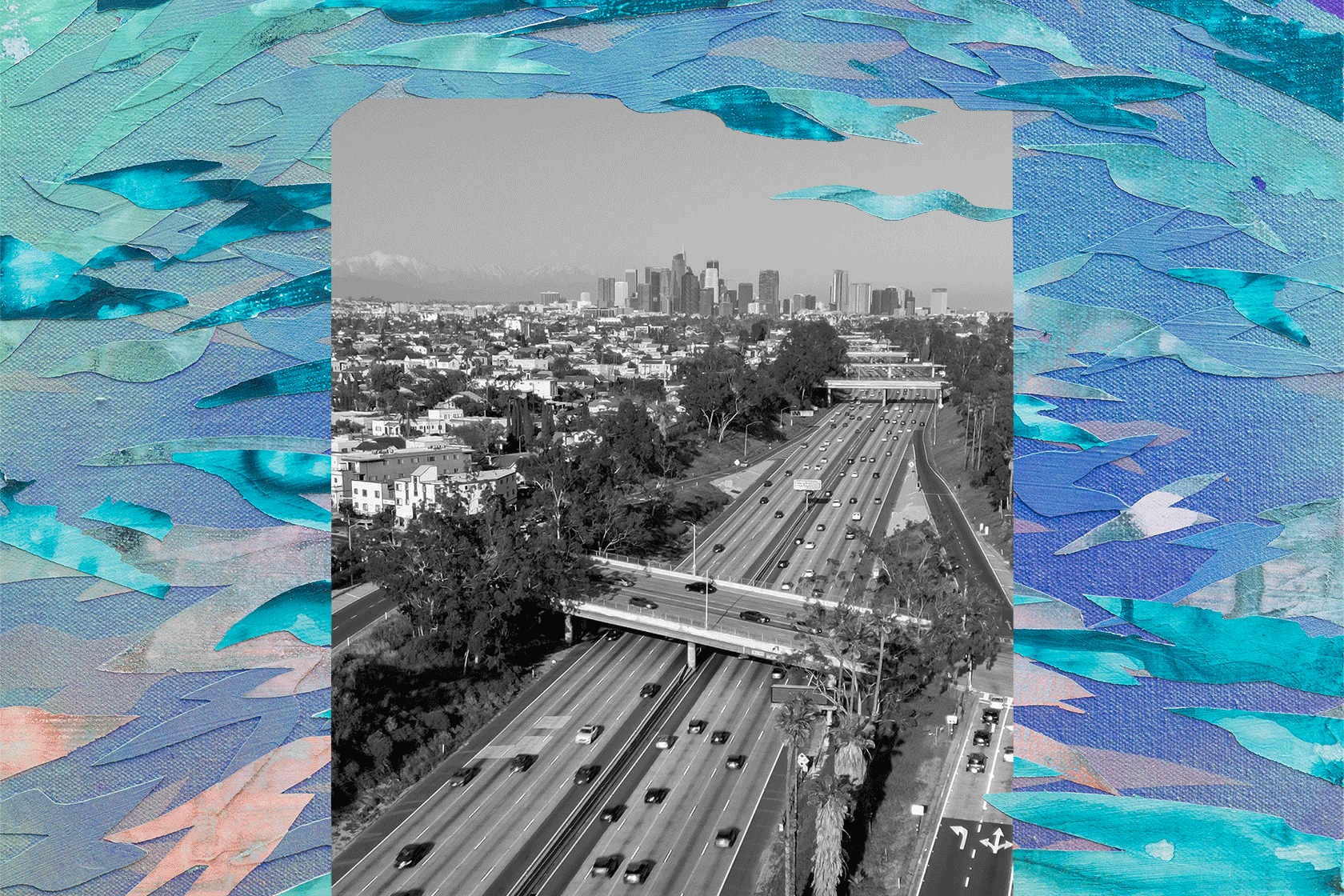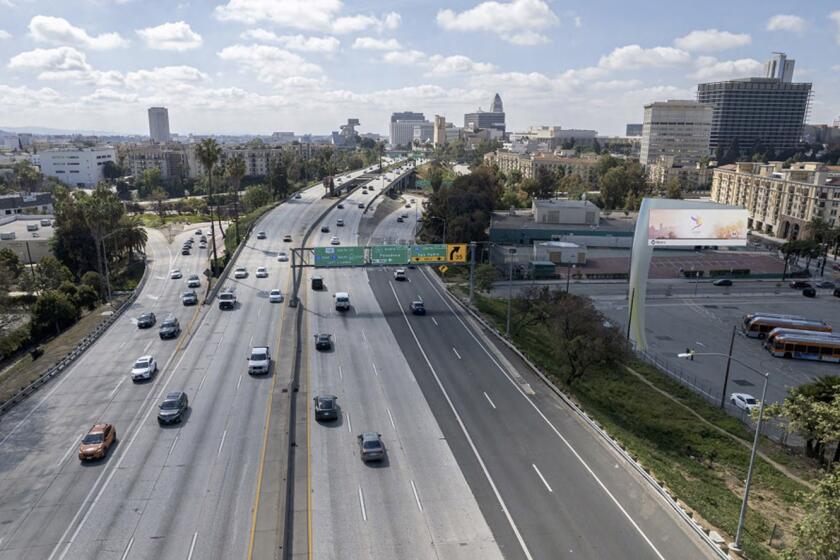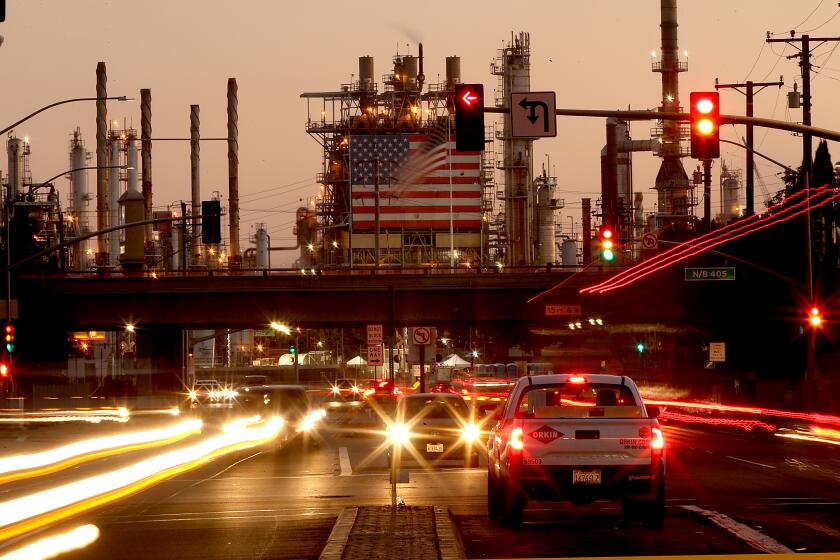This L.A. freeway is the butt of many jokes. Can it have new life as parks and housing?
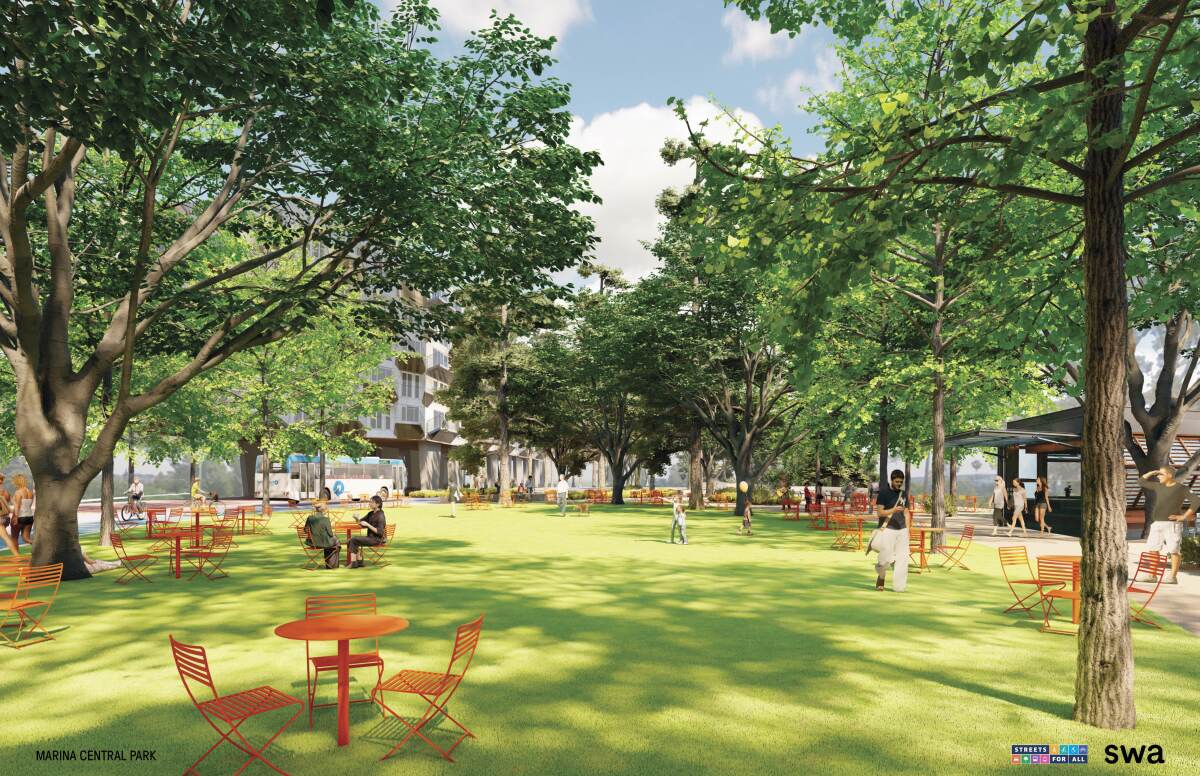
The Marina Freeway has long been a peculiarity on the map of Southern California.
Envisioned initially as a major route from the Pacific Ocean to northern Orange County, it stands as a testament to the fading era of freeways.
Caltrans built a three-mile stretch from the 405 Freeway to the edge of Marina del Rey. But community opposition in the 1960s scuttled the full freeway. Over the years, it went by many names: the Slauson Freeway, the Richard M. Nixon Freeway and, as Johnny Carson once mocked it, the Slauson Cutoff.
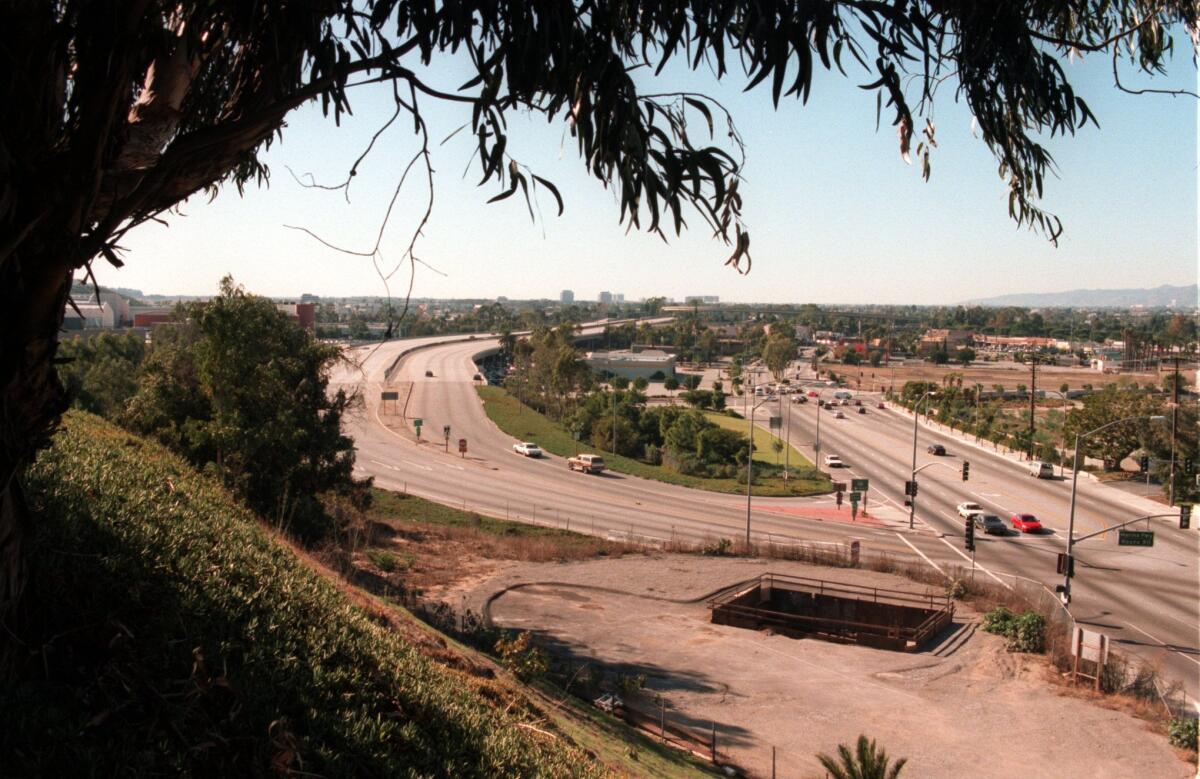
Now some community activists are calling for unfinished Route 90 to fade into history, replaced by thousands of homes and one of Los Angeles’ largest public parks. It is the latest in a series of proposals to take back highways across the country.
The vision, said Michael Schneider, chief executive and founder of Streets For All, is to transform the road that was left incomplete in the 1960s into about 130 acres of green space and nearly 4,000 residential units.
Similar ideas have been weighed in the past, including California State Routes 2 in Silver Lake and 103 in Long Beach. The routes have been found to be either too busy with traffic or too isolated from neighborhoods. The 90 Freeway, some believe, may be just right.
If we said when you woke up tomorrow that the 10, the 91, the 118 freeways and the East L.A. Interchange had vanished, would you dare to look directly at the brave new world?
“This may be the Goldilocks of converting freeways to green space,” said Paul Haddad, author of “Freewaytopia: How Freeways Shaped Los Angeles,” a book that examines the history and impact of freeways. “I think it could be a sweet spot.”
Local governments and groups across the country have recently pushed to reimagine public streets and highways, advocating for more pedestrian-friendly thoroughfares and events that promote more walking and less driving.
In Los Angeles County, CicLAvia festivals have temporarily shut down miles of traffic-filled streets to cars and opened them up to bikes, skateboards and walkers. On Oct. 29, six miles of the busy Arroyo Seco Parkway in Pasadena — the 110 Freeway — will be shut down to drivers and opened instead for people to walk, bike or skate.
But the project proposed by Streets For All would create a more permanent transformation.
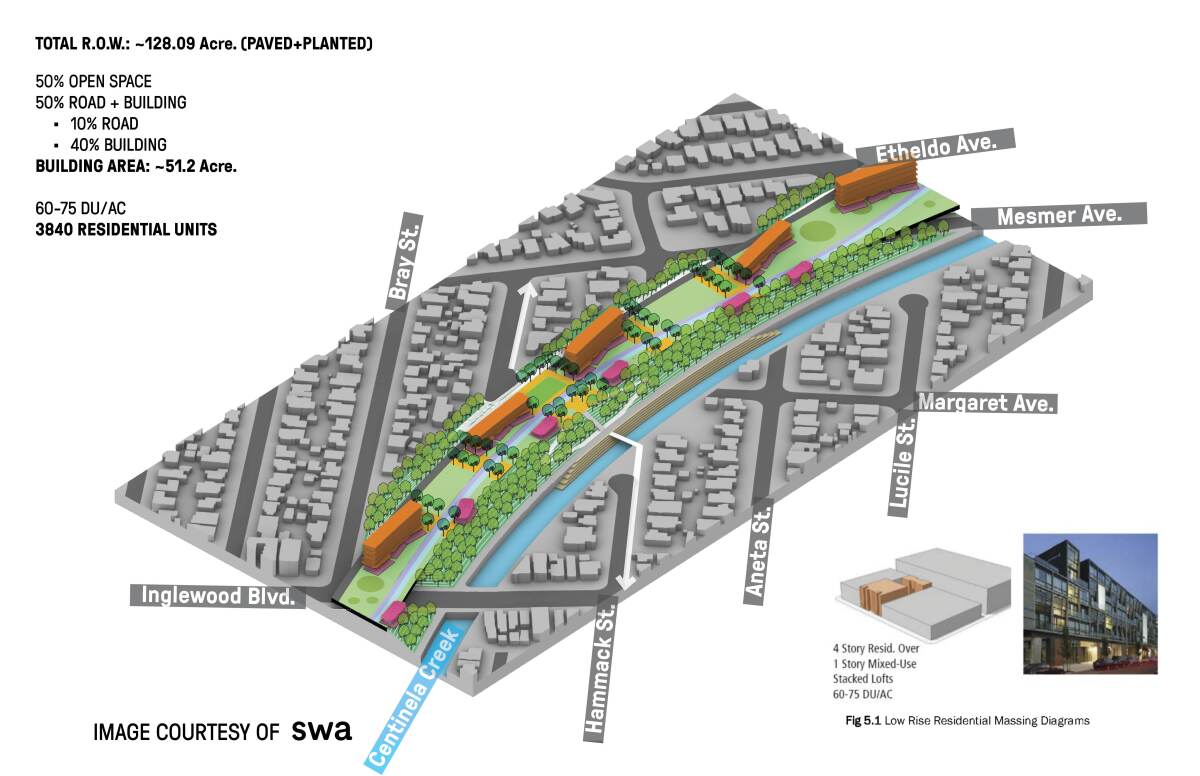
“We don’t think anything should be a sacred cow,” Schneider said. “Instead we should think: ‘Maybe there’s something better for the city.’ ”
Los Angeles lacks available green space and is struggling with a housing crisis, and the city must be willing to consider all options to address those issues, Schneider said.
The project was developed by Streets For All, a nonprofit political action committee that looks to fight climate change by tackling traffic and public transportation issues, and the L.A. office of SWA, a planning and urban design firm.
The Marina Freeway was originally named the Slauson Freeway when construction began in the 1950s. It was meant to run from Marina del Rey through south L.A. County and into Orange County.
It was initially intended to intersect with the 405, 110, 5, 605 and 710 freeways, Haddad said.
The route was at one point named after President Nixon, but the name was dropped after the Watergate scandal. Over the years, it wasn’t just the freeway’s name that got the ax.
Los Angeles 2043: Imagine a metropolis where many people have forsaken cars in favor of e-bikes, robo-taxis and public transit.
What was supposed to be a 40-plus-mile route never came to be. Instead, only three miles were constructed from Marina del Rey to just beyond the 405. A second, unconnected short portion of the 90 also sits 40 miles away in Yorba Linda.
The death of the 90 Freeway’s planned route was the result of local opposition, national crisis and waning interest, Haddad said.
The initial plan got push-back from business groups in the 1950s and 1960s, Haddad said. Opposition grew to such a fervor in the early ’60s that some businessmen met with a state assemblyman with whom they allegedly discussed a $10,000 bribe for the lawmaker to introduce legislation to reroute the freeway.
Assemblyman Lester A. McMillan was secretly recorded saying that, for the fee, he’d introduce the legislation. He was indicted in April 1965 on a charge of seeking a bribe. McMillan’s attorney argued in court that despite the recording, the legislator didn’t intend to introduce the bill because the Legislature was in recess, and that the fee was instead for McMillan’s expenses to work with the group, according to The Times’ coverage of the trial. He was acquitted later that year, after the judge ruled there was reasonable doubt whether the $10,000 discussed was indeed a bribe.
By the late ’60s, support for the Marina Freeway and others had dwindled, and construction plans were practically dead by the ’70s because of inflation and gas shortages, Haddad said.
Today, the unfinished freeway acts more as a “glorified offramp” of the 405, Haddad said.
Under the project, dubbed Marina Central Park, the freeway would be turned into one of Los Angeles County’s largest public parks. About 50% of the land would remain open space, and the other half would be used for roads and buildings.
The project, across roughly 128 acres, would include 11 four-story mixed-use buildings, with the first floor used for businesses and the remaining floors for homes.
The plan would reconnect neighborhoods that sit on opposite sides of the 90 Freeway and provide access to Centinela Creek, the Ballona Creek trail and Ballona Wetlands Ecological Reserve.
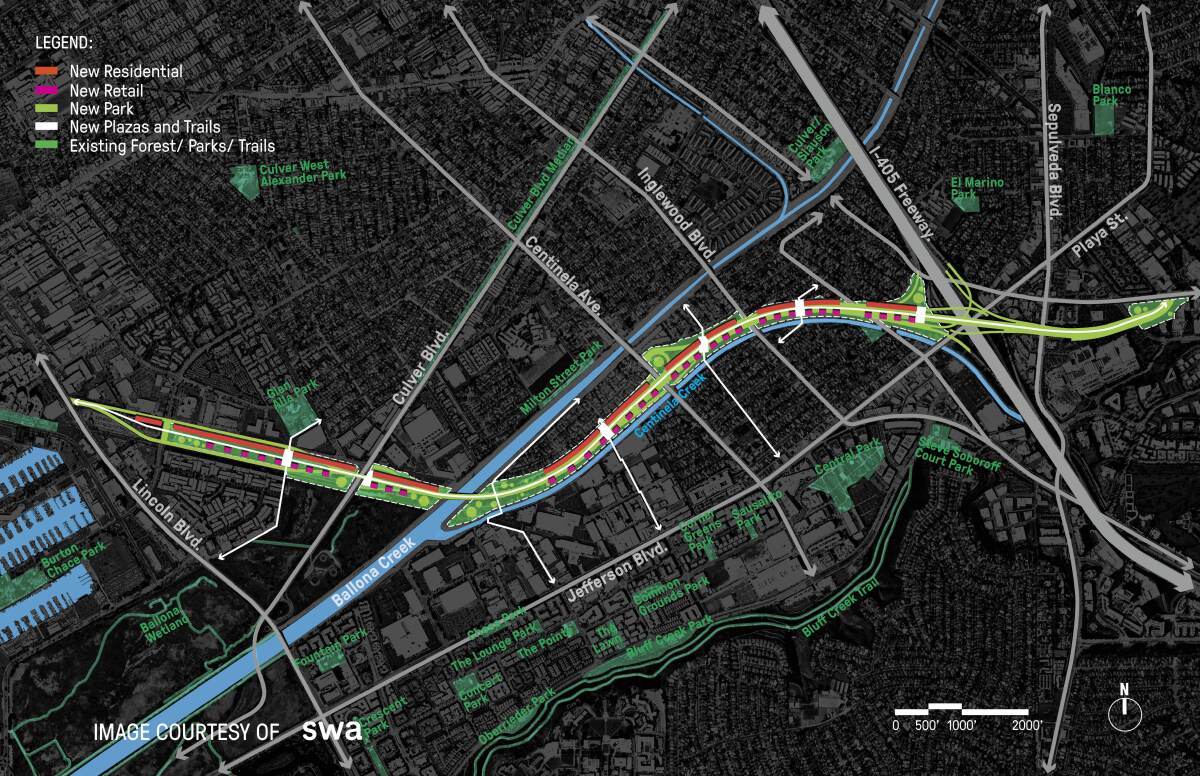
The project would also include streets but, according to Streets For All, motorists would have the option of driving along Jefferson Boulevard, which runs the length of the 90 Freeway.
It’s unclear how converting the freeway would affect traffic, congestion and other factors in the area, but Streets For All is hoping to fund a feasibility study that would study those potential issues.
Reimagining Los Angeles freeways for other uses may be unique for the area, but wide thoroughfares have been converted in other major cities.
In San Francisco, the Embarcadero Freeway, or State Route 480, was demolished in 1991 after it was damaged in the 1989 Loma Prieta earthquake, Schneider said. The area was replaced with a wide boulevard that extended public transportation.
In Utrecht, in the Netherlands, a 12-lane motorway was replaced with canals and green space, restoring the original waterways that had been paved over years ago for roads.
The Biden administration is looking to fund similar projects to address problems created by previous highway construction and other infrastructure that divided communities, often cutting out minority neighborhoods. The administration in March proposed $20 billion toward that effort.
Metro’s plan to bring new digital billboards to downtown, the Westside, the San Fernando Valley and other areas now heads to the City Council.
The freeway construction boom of the 1950s and ’60s under the Federal-Aid Highway Act helped ease congestion in rapidly growing cities, but it came at a cost. Black and other minority communities were disproportionately affected in the rush to construction. Minority communities were cut off from city resources and displaced from the land needed to build the freeways.
“Interstate routes were chosen based on areas where land costs were the lowest, or where political resistance was the weakest,” according to a Department of Transportation report, Beyond Traffic 2045. “In practice, this meant that urban interstates cut through low-income and minority communities more often than not.”
Earlier this year, U.S. Transportation Secretary Pete Buttigieg announced a $185-million program, Reconnecting Communities and Neighborhoods Grant, to fund projects that reconnected communities “by removing, retrofitting or mitigating highways or other transportation facilities.”
The program has already provided money to transportation projects in California, including a plan in Long Beach to turn 5.6 acres of roadway that divides Cesar E. Chavez Park near the 710 Freeway into park space, according to a project summary. The city of Fresno was awarded a $600,000 planning grant for a pedestrian bridge over Highway 99.
Streets For All plans to apply for the federal grant to pursue the Marina Freeway project, Schneider said.
The organization hopes that, if approved, the grant will help pay for a feasibility study that’s estimated to take about 22 months and cost $2 million.
The project has already garnered some support. According to Streets For All, Assemblymember Isaac Bryan and Sen. Lola Smallwood-Cuevas — Los Angeles Democrats whose districts represent the area — have voiced support for the project, as has the Del Rey Neighborhood Council.
Officials with Bryan’s office and the Del Rey Neighborhood Council did not respond to requests for comment.
A spokesperson for Smallwood-Cuevas confirmed she has submitted letters supporting the project to Buttigieg and to Caltrans Director Tony Tavares.
“This is a forward-thinking project that would help alleviate L.A.’s need for open space and affordable housing,” Smallwood-Cuevas said in a statement.
Southern California air regulators adopted a rule that has forgiven more than $200 million in pollution fees from facilities that emit smog-forming chemicals.
Los Angeles Mayor Karen Bass has also voiced support for the project, writing a letter to Buttigieg endorsing Streets For All’s efforts to obtain the federal grant.
“The daily traffic volumes prove that an eight-lane freeway is not needed for this corridor,” the letter reads. “The freeway destroyed homes in both Culver City and the Del Rey Neighborhood of the City of Los Angeles, and made access to Centinela Creek difficult.”
She called the 90 Freeway a “freeway to nowhere.”
“Tearing down the Marina Freeway, which sits in 100 acres of right-of-way with 50 acres of concrete and steel, represents an opportunity to address past harms, build housing, and create community space for all Angelenos,” Bass wrote.
A spokesperson for Los Angeles City Councilmember Traci Park, who represents the area, said their office is reviewing the proposal.
Haddad concedes that Los Angeles’ urban sprawl and reliance on cars makes such projects a tough sell. But he believes there may be growing support.
“The mind-set is changing,” he said. “There would be people who are upset, but I think there are people who are still craving to turn Los Angeles more to its natural state, or at least make it more livable, more walkable.”
More to Read
Sign up for Essential California
The most important California stories and recommendations in your inbox every morning.
You may occasionally receive promotional content from the Los Angeles Times.
